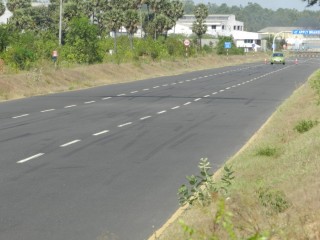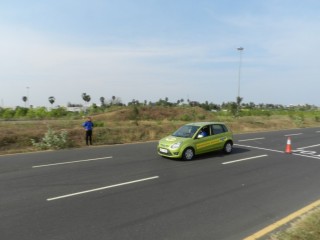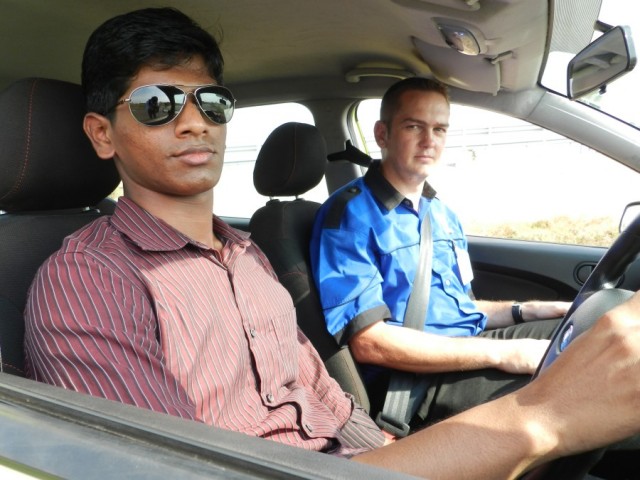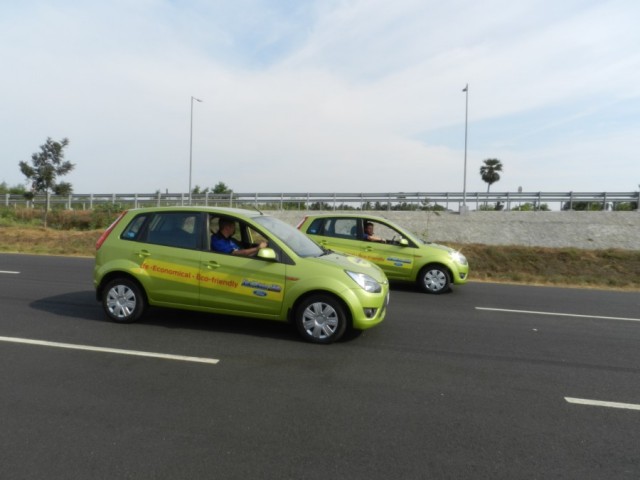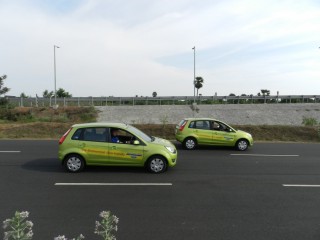The Driving Skills for Life program from Ford varies with location. While the program in the US is geared to equip teen drivers with the necessary driving skills for safe driving, the one we experienced – DSFL Snack Program – focuses on Safe, Economical and Eco-Friendly driving. The program was conducted at the Ford India plant in Maraimalainagar, Chennai.
That is how the instructors grab your attention during the theory sessions. A difference of 5kph can result in that drastic a difference in braking distance. It takes a video like this to grab people’s attention and tell them 65 kph is just not the same as 60 kph.
The other most important thing taught at DSFL is the 3 second rule. Maintain a safe three-second distance from the vehicle in front of you. There is no fixed ‘safe distance’ since it varies with different speeds of the car, instead it is recommended to follow the car ahead of you at a safe ‘three-second’ distance. How do you establish the three second distance? Pick a stationary point on the road, a lamp post, sign board or a tree, when the car in front of you passes it, you should be able to count to 3 before you pass the same object. Ford also recommends that if the weather is bad and visibility is low, increase the time interval to 6 seconds.
After having witnessed the traffic in India, Kirkby agrees that maintaining the three second rule in the city is nearly impossible, but that doesn’t mean this rule is ineffective here. On the highways, the three second rule makes fantastic sense. Experienced drivers already practice this rule but know it simply as the ‘safe distance’. For the learning driver, the three second rule clearly defines what the ‘safe distance’ is. In the city limits when the traffic isn’t so bad and average speeds are slightly higher, the three second rule can help.
A summary of all the points taught during the theory session of the DSFL Snack Program is available at DrivingFord.in
After the theory session was over, we were driven to the Ford Test Track in Figos and Fiestas. The sun which was surprisingly shy for an April day, was hiding behind the clouds all the morning and just as we headed to the track, decided to show its face, in all its glory! We were in one of the all new the Fiestas, the Ambiente edition to be precise and the trip was a short one to the track, but since Ford has a 15 Kmph speed limit inside the factory limits, the journey to the track seemed to take forever!
After about 10 minutes we reached the track and Nick and Derek were ready to go. The first demonstration was about braking. We were to be shown the stopping distance of a Figo with ABS, from 60 kph to a standstill, and without reaction time, because the braking point was already known.
We were asked to choose a position by the side of the track where we thought the car would stop from 60 kph to 0. After everyone had taken their positions, Nick started from the far end of the track built up speed to 60 Kph and kept it there. As soon as he reached the braking point, he hit the brakes as hard as he could and stopped within a few feet from the braking point, without any real drama, which was an advertisement clearly demonstrating the benefits of ABS.
Then Nick was to repeat the same experiment at 120 kph and we were similarly asked to take positions on the side of the track where we thought he would stop. And when that was done, Nick started again and built up the speed to 120 kph, and slammed the brakes at the braking point. And this time there was drama as the car struggled to slow itself down from 120 kph to 0. And Nick stopped the car in time and barely avoided going off the track. The same driver, the same car, but still when speeds were increased, it covered a lot of ground before it eventually stopped. Twice the speed, and the braking distance more than triples! And this was in a situation when the driver actually knew where the braking point was. In an everyday situation, what with your traffic, and your distractions and your reaction time, things could have been very different.So the message is clear. It is always safe to keep the speed down as much as possible because we never know what is gonna happen on the road ahead and we need to be able to stop in time.
After Nick had finished his demonstration, two volunteers were asked for from the people present to have a go at this and see what it feels like to slam the brakes on a car from 60 kph. I was one of the volunteers and so I got into the Figo and lined up at the starting point. I built the speed up to 60 and held it there steadily until I reached the braking point, and pressed my foot har don the brake pedal. The car came to a halt without much drama.
I have had a few scary moments in my car, when I have had to brake unexpectedly. And most of the times it would be alright, but sometimes, the front wheels tend to lock up, the car being a Honda City Vtec, without ABS. And I can tell you, the advantages of having ABS system in the car is a blessing! When the front wheels lock up, you are not actually stopping, but you still travel some distance until the laws of physics decide you have had enough and make you stop. Having an ABS system fitted to your car would avoid the front wheel lock up, and you will stop sooner.
After this exercise, Nick and Derek would now show why it is important to have a reasonable gap between yourself and the car in front.
Derek would first set off and Nick would follow 1 second later on a different lane and they would both come at a steady 60 kph and start braking at the braking point on the track and Nick would brake as soon as he saw the brake lights of Derek’s car. When they reached the braking point they both braked and Nick’s car was almost paralel to Derek’s car. If they had been traveling in the same lane, they would most definitely have had a crash.
Derek and Nick then said they would repeat the same experiment with distances of 2 and 3 seconds. And in the experiment where Nick followed Derek 2 seconds later, they would still have collided if they had been on the same lane.
But in the experiment where Nick left 3 seconds later, he had plenty of time to react and therefore he stopped well ahead of Derek and they would not have collided even if they had been on the same lane.
So DSFL always suggests that you maintain a 3 second gap to the car in front of you to allow time for your reaction and avoid crashing into it, in case of an emergency stop.


